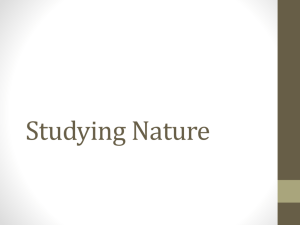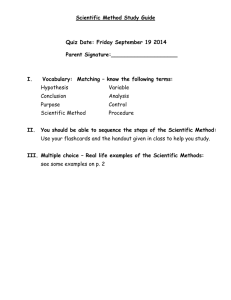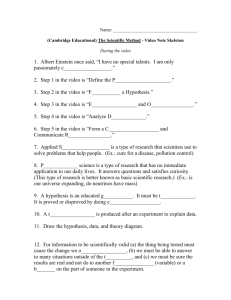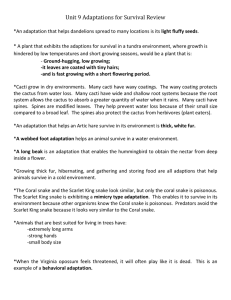What is Science?
advertisement
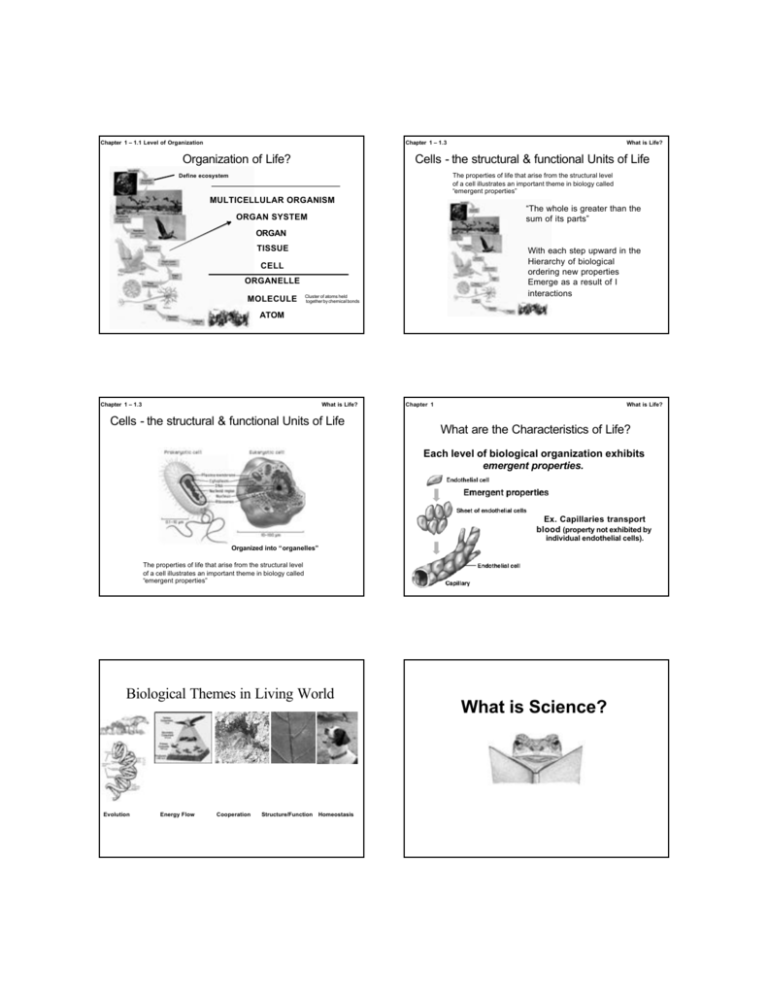
Chapter 1 – 1.1 Level of Organization Chapter 1 – 1.3 Organization of Life? What is Life? Cells - the structural & functional Units of Life The properties of life that arise from the structural level of a cell illustrates an important theme in biology called “emergent properties” Define ecosystem MULTICELLULAR ORGANISM “The whole is greater than the sum of its parts” ORGAN SYSTEM ORGAN TISSUE With each step upward in the Hierarchy of biological ordering new properties Emerge as a result of I interactions CELL ORGANELLE MOLECULE Cluster of atoms held together by chemical bonds ATOM Chapter 1 – 1.3 What is Life? Cells - the structural & functional Units of Life Chapter 1 What is Life? What are the Characteristics of Life? Each level of biological organization exhibits emergent properties. Ex. Capillaries transport blood (property not exhibited by individual endothelial cells). Organized into “organelles” The properties of life that arise from the structural level of a cell illustrates an important theme in biology called “emergent properties” Biological Themes in Living World Evolution Energy Flow Cooperation Structure/Function Homeostasis What is Science? Two Broad Categories of Science • Discovery Science • Hypothesis -based Science Reasoning DEDUCTIVE Generalizations ? specific conclusions INDUCTIVE Discovery Science • Describing Nature • Examples could range from sequencing a the genetic makeup of a species to making a list of animals and/or plants that live in a defined region (e.g., Furman’s campus, a state park, a national park or an entire ecoregion. Discovery Science By means of “inductive reasoning”, discovery science can lead to important conclusions (e.g., when “old growth” southern pines are removed the listed red-cockaded woodpecker disappears.) Events ? Generalizations Hypothesis-Based Science Hypothesis-Based Science Discovery Science stimulates inquiring minds to ask questions and seek explanations. A hypothesis is a “tentative” answer which is on trial so-to-speak. Deductive reasoning is the logic used to test hypothesis Hypotheses must be “testable” and “falsifiable” Hypothesis: Mimics benefit because predators confuse them with harmful species Case study: David and Karin Pfennig, UNC Chapel Hill Eastern Coral Snake King Snake Eastern Coral Snake Hypothesis: Mimicry should protect the King Snake but only in areas where Coral Snake occurs. Eastern Coral Snake Scarlet King Snake These two species both live in the Carolinas of the Southeast US but the king snake’s range extends further predators How do we study the Natural World? Scarlet King Snake Researchers put over 1000 artificial snakes (colorful banded and plain brown) north south Fig 1.8E Control group This experimental design left coloration as the only factor that would explain low predation on artificial king snakes How do we study the Natural World? What is difference between hypothesis, theory & law? Observations Question Hypothesis - “an educated guess”; a tentative explanation of phenomena. Hypothesis Prediction Experiment Theory - a widely accepted explanation of natural phenomena; has stood up to thorough & continual testing. Law - a statement of what always occurs under certain conditions. How do we study the Natural World? How is a control group different from an experimental group? Control group: Control groups are not manipulated. They are the foundational point for which to compare the experimental group against. Four Theories Unify Biology as a Science Experimental group: The group being treated, or otherwise manipulated for the sake of the experiment. This group is identical to the control group EXCEPT that it is manipulated. Chapter 1 – 1.4 #1 – Cell Theory – all living things… What is Life? #2 Gene Theory – the basis of inheritance Unit of Life – All forms of Life have common features DNA! #3 – The Theory of Heredity – chromosomes inherited #4 – Theory of Evolution Chapter 1 What is Life? Chapter 1 What are the Characteristics of Life? All living things exhibit seven characteristics in combination. Chapter 1 What is Life? What is Life? What are the Characteristics of Life? 1. Order – complex organization 2. Regulation – maintain internal environment 3. Growth & Development – regulated by inherited genetic information 4. Energy Utilization – take in energy & convert it 5. Response to the environment – responding to stimuli 6. Reproduction – all organisms reproduce their own kind 7. Evolution – species change over time – nature acts on genetic variations Chapter 1 Life is Diverse What is Life? Life is Diverse Pronounced “R” – “key ” – “ahh” Biodiversity refers to the many different types of organisms on earth. Taxonomy is the biological science that classifies life according to evolutionary relationships. The Domain is the largest group of organisms. Can not form spores and can use more Compounds for energy (some use hydrogen gas!) Chapter 1 What is Life? Life is Diverse Chapter 1 What is Life? Life is Diverse Human classification scheme: Kingdom Phylum Class Order Family Genus Species Kings Play Chess On Funny Green Squares Domain Kingdom Phylum Class Order Family Genus & species Eukarya Animalia Chordata Mammalia Primates Hominidae Homo sapiens
